Honeybees may inherit altruism from their mothersZME Science
How I Remove Beehives From the Walls of HousesSlate
Today, Mud, founded in 1994, has 11 stores from Marrickville (where its HQ/workshop is) to Marylebone, London, via New York, Los Angeles, Byron Bay and Fitzroy in Melbourne.
The way light bounces off porcelain glaze has long intrigued Simpson, as has the way biscuity finishes seem to absorb luminosity. In fact, Mud produced some lampshades, essentially inverted vessels suspended on cord, some 20 years ago.
The Australian porcelain brand loved by Gwyneth, Nigella and David Chang
After nearly three decades of building her porcelain homewares business Mud Australia into a globally recognised brand, Shelley Simpson still loves pottering around.
Mud is not the kind of business to move fast and break things. But Shelley Simpson, founder and owner of the nearly 30-year-old ceramics purveyor, does love to break porcelain. She picks up a fragment of what was once a bowl that’s destined to be recycled and pitches it with great vigour into a bin filled with cracked Mud pieces. It smashes violently into several pieces.
“Have a go,” she says with a grin. I don’t really want to – in my house, Mud is precious. The children are not allowed within a metre of it. I wash it by hand, terrified of what fate it might meet in the dishwasher. But these pieces have been vanquished anyway, broken along the way to becoming ceramics and destined to be turned into kitchen benchtops or terrazzo tiling. I pick up half of a noodle bowl in blossom, a pleasing powder pink, and give it a whirl, tossing it into the bin.
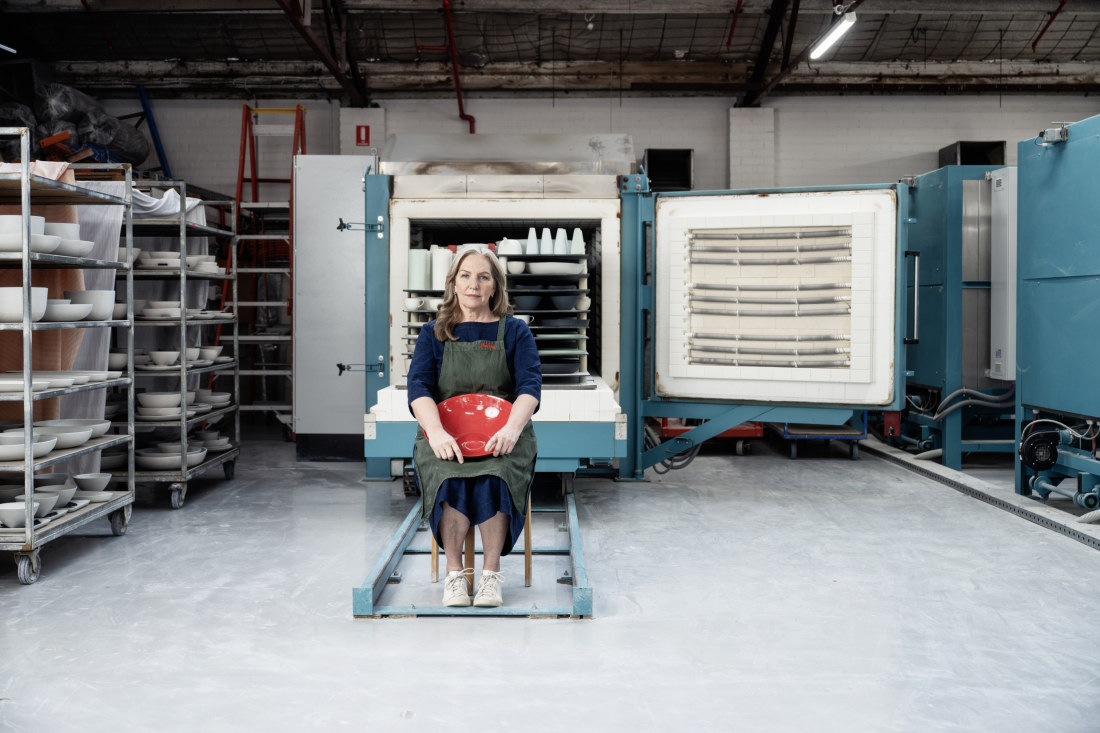
Shelley Simpson of Mud at her warehouse in Marrickville, Sydney. Louie Douvis
It does not break. I try again. In fact, I try three times. My weak throws don’t result in so much as a crack.
“It’s pretty tough stuff,” Simpson says. “People think they have to be so careful with it but honestly, I would just hate that. Things do break. But Mud is pretty sturdy.”
That is underselling it somewhat, but also a neat metaphor for the company. Mud is, in its own quiet way, a very successful business. It sells a kind of quotidian beauty – splendid objects meant to be used every day. It’s all made in Marrickville, a Sydney suburb that is slowly being gentrified but retains much of its industrial heritage and grungy feel.
It is sold everywhere from Marylebone to Mosman. Chefs love it. It’s featured regularly on the pages of Architectural Digest. When Gwyneth Paltrow married for the second time, chef Francis Mallmann served his salt-crusted wild salmon on Mud plates.
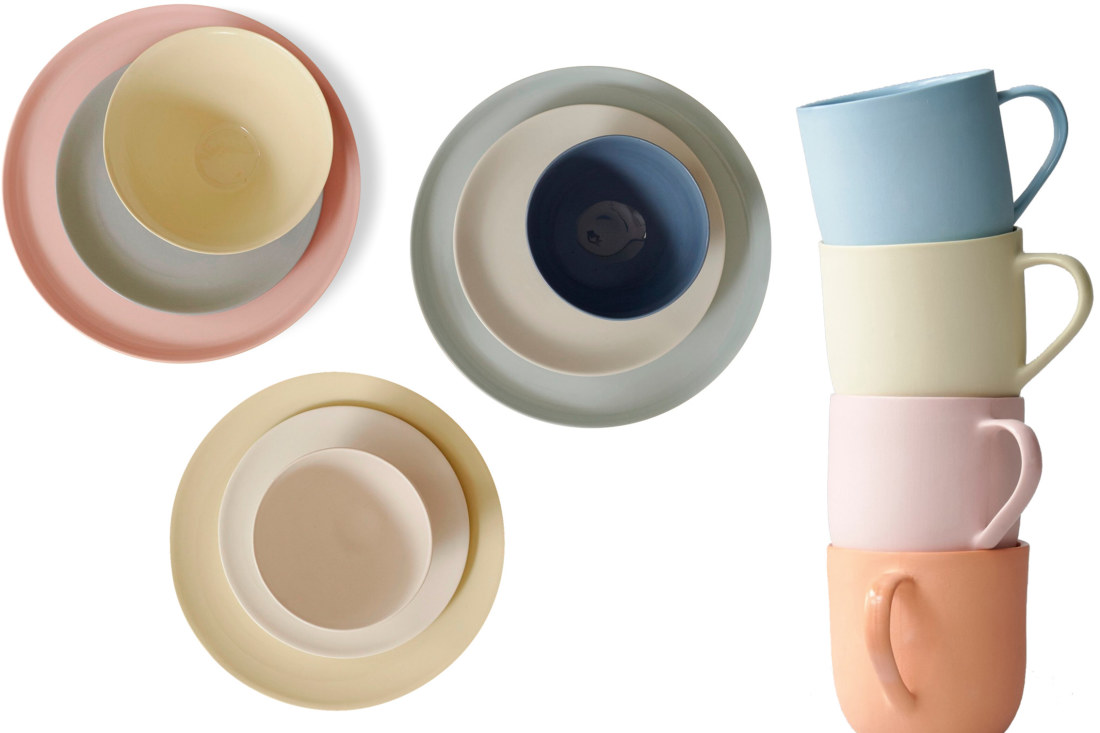
Mud pieces. “Donna [Hay] taught me about colour, and that a risotto bowl is different from a soup bowl,” says Simpson.
Mud HQ sits on a quiet corner, tucked behind a primary school. The sign on the exterior is so small as to nearly go unnoticed. This is where every piece of Mud is made, transformed from clay by a man named Jesse, to the refined, elegant homewares that reinvented the genre. When Fin Magazine visits, the team is working, in their hushed, industrious way, on a major order for Net-A-Porter, Mud’s most recent wholesale partner and one of the world’s biggest fashion retailers.
Jesse starts the process, taking clay and adding pigment to create a pourable mixture. Mud is known for its punchy colours with a matte exterior, the outcome of Simpson’s early experimentation as she taught herself how to make pottery. “I poured the underglaze into the clay body and loved the results of the intense, matte colour.”
Mud’s story – and Simpson’s story – is, appropriately enough, a tale of organic growth. A former theatre manager, she was 29 when, in 1993, she lost out on a plum role at Sydney’s State Theatre. She was at a crossroads and picked up pottery as a hobby, encouraged by her then-flatmate. Simpson, who exudes calm, found she had a knack for making ceramics and opened a small studio in Surry Hills in 1994. Neil Perry (then at Rockpool) and Donna Hay (then working on the food pages of Vogue Entertaining magazine), who both worked nearby, were early customers who became collaborators.
“Donna taught me about colour, and that a risotto bowl is different from a soup bowl,” says Simpson. Perry ordered such a quantity of Simpson’s early work – made in earthenware, which is softer than porcelain and more prone to breakages – that it prompted her to shift to the hardier material.
“I’ve always found people have been very generous with their feedback,” says Simpson, who knows each worker by name and lives above the warehouse with her husband, James Kirton. “I wasn’t precious about it being ‘mine’. I like collaborating, I like working with people.” It might be her theatre training, I suggest. “Maybe,” muses Simpson. “I do like working in an ensemble.”
Simpson started Mud when she was 31, initially with a friend. It was called Common as Mud in the beginning, a joke between the co-founders. “I had made some terrible ceramic gifts for people,” she says. “But they seemed to like them. And I thought, this is fun. It’s creative, it’s interesting.” Before she worked in theatre she had worked in hospitality; she liked both industries but found them, literally, tiresome. “They take you away from people. You’re with people all the time but you’re away from the people you love. I didn’t want that any more.”
She launched the business while she was working as a nanny and with funding from a government scheme. With Perry and Hay as early customers, success came swiftly. Open an old copy of Donna Hay magazine and you’ll see duck-egg Mud plates aplenty. It sparked a craze: in 2008 a Woollahra store opened. In 2012, a New York store opened in Soho, and five years later came LA.
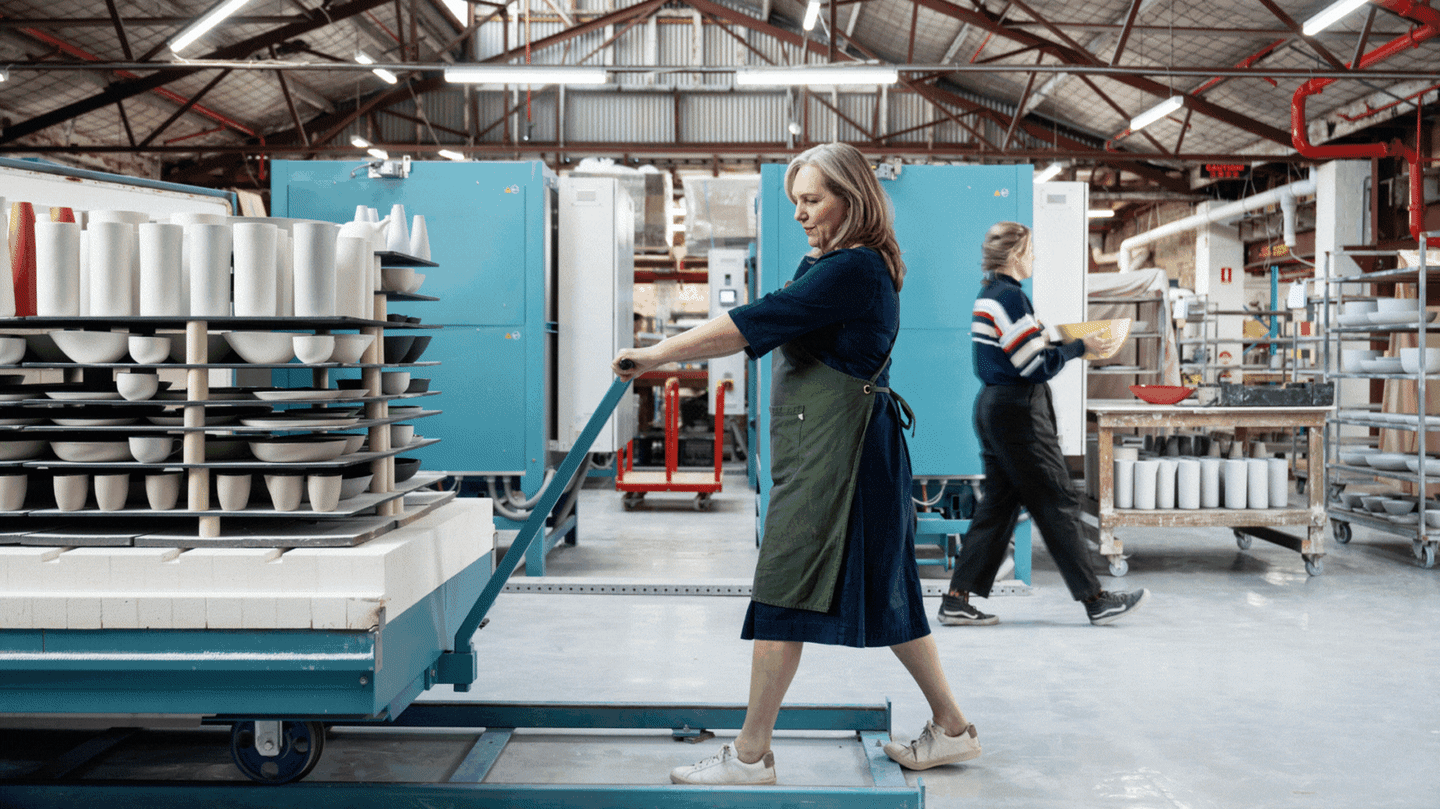
Shelley Simpson on the Mud factory floor with the kilns, which fire each piece for 24 hours; upstairs at home with her dog, Molly. Louie Douvis
Hundreds of people now queue for the Mud seconds sale, where imperfect pieces are sold at discounted prices. Simpson herself still mans the tills, and carefully wraps slightly wonky espresso cups for customers who likely have not the faintest that this is the woman who started the brand.
For all the external success, Simpson still operates much like a sole trader. One customer asked her to make a teapot and she obliged happily. Other requests are trickier.
David Chang visited the studio when he opened Momofuku Seiobo in Sydney. “I was a huge fan,” says Simpson. “I couldn’t speak when he came in.” Chang wanted carafes that would keep sparkling water bubbly, and asked Simpson what she could do. She made a jug with a tapered neck, which he eventually bought for his New York restaurants. “I like unravelling the slinky. When it’s all tangled and nobody wants to play with it any more, that’s when I step in and nut out the problem.”
One problem was how to structure the ceramic-making process, which is unique to Mud. The steps involved in taking the product from clay to store-ready ceramic is like a human Rube Goldberg machine, propelled by workers carrying the ceramics carefully to the next stage. Most people come to the company without prior experience in pottery, which Simpson likes.
“Our process is quite different,” she says. “We’ve set up a sort of apprenticeship program, and people move up the levels.” Teams of four are given a list of 240 pieces to make each day, though this, says Simpson is “a guide, not a rule. We’d love you to get 80 pieces [per person] done. But it’s also just pots.”
Clay is poured into moulds, poured off and shaped with a sponge. Twenty-four hours later, when the pieces are dry, they are smoothed again and glazed. Pieces with cracks can be rescued with hot water, which softens the clay and allows it to be manipulated. Some can’t be, and they are sent to the recycling bin to be made into new pieces or terrazzo tiles.
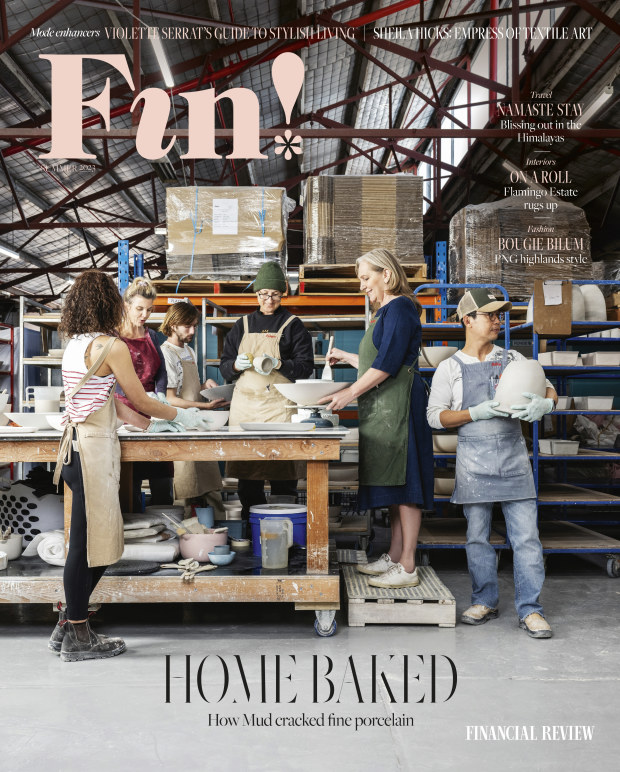
Fin Magazine’s summer issue published on October 14, 2023. Louie Douvis
Everything, even the small “Mud” etching on the bottom of each piece, is done by hand. “We used to have a sticker,” says Simpson, “but it fell off within a minute. So someone threw down the challenge of hand-stamping it.”
Using a stencil and a sharp knife, the Mud logo is engraved within seconds. There is more drying, more glazing, and finally the kiln is fired. Mud has nine Rohde kilns, which were flown in from Germany and constructed in situ. Each piece is fired for 24 hours and then carefully cooled, a process that’s just as important. Finally, the bases are sanded one more time. “I hate the idea that a bowl might scratch someone’s table,” says Simpson.
In April 2023, Mud opened a second London store, in Marylebone. The tony neighbourhood is exactly the kind of place Mud belongs: opposite The Ribbon Shop, next to Ottolenghiand St John’s. “It’s like Bridget Jones’s Diary,” says Simpson. On the first day of trade, British food writer Nigel Slater came by. “The credit card machine wasn’t set up, which was a nice way of being able to say, ‘please put your money away’.”
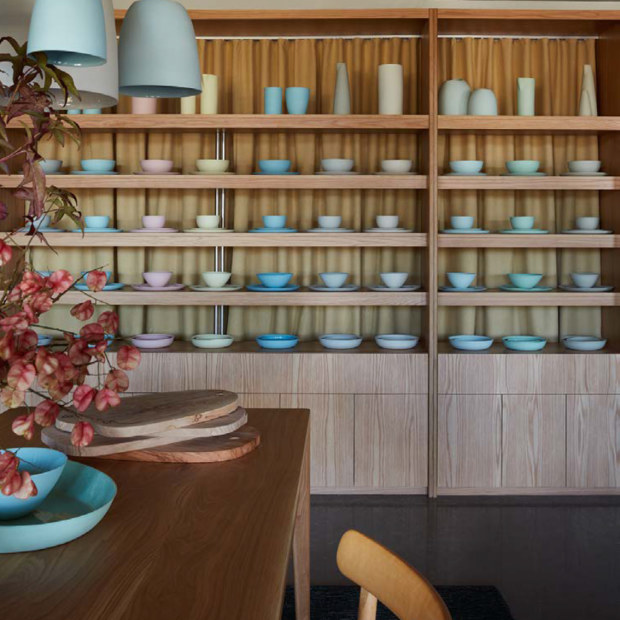
Mud wares in a rainbow of pastels.
Mud platters are soon to be installed at Ottolenghi, after Simpson’s friend Nigella Lawson introduced Yotam to the brand. “It’s amusing when [Nigella] visits,” says Simpson. “People don’t really know how to speak any more. They get tongue-tied. So I don’t force it. We usually go out for dinner.”
Thirty years in, Simpson has no intention of selling the business she has built. She thinks there may have been offers, but says her team insulates her from approaches. They also shield her from competitors imitating Mud, though Simpson has made peace with that.
“I used to hate competition, especially [from] local [companies]. I thought, why would you do things like we have already done? But it’s a negative sort of energy that I don’t like taking around with me.” These days she’s more sanguine about it. “This is very hard to do so I think . . . good luck to you. This is hard. You have to be able to sustain it. And if you copy, you’re always going to be second.”
So far, nothing is planned for Mud’s 30th birthday, a celebration that will span the year. Simpson wants to throw a party for her staff, but that’s as far as the organising has gone. Apart from her products, she cemented her legacy in 2020 when she introduced the Shelley Simpson Ceramics Prize, awarding $10,000 to an emerging leader in the field.
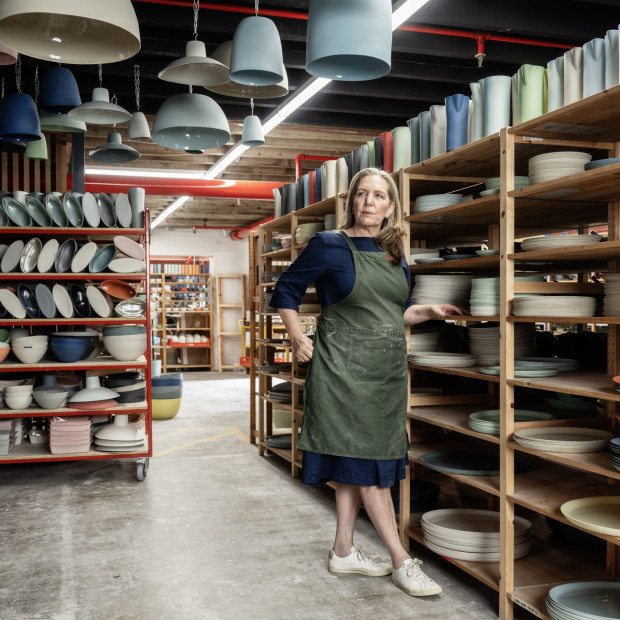
“I get to make beautiful things, and have fun doing it,” says Simpson. Louie Douvis
She doesn’t think too much about the brand’s global reach, the fact that Mud plates have become the go-to wedding and housewarming gift for a discerning crowd, that the pastels are synonymous with a generation of dinner parties and long lunches.
“I feel like I spend a lot of time in the coalmines,” Simpson says. “I get up and take the dog to the park, I’m in meetings. I don’t think too much about the global nature of the business. I’m just so pleased I worked out how to do something I love to do, that people like me doing. Life can be a bit of a crapshoot. But I am very lucky. I get to make beautiful things, and have fun doing it.”
